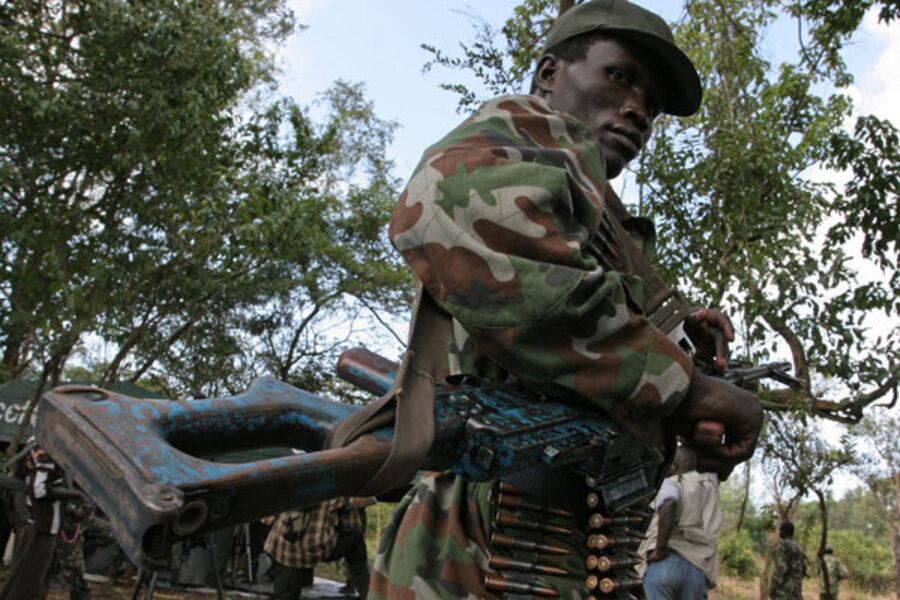Human Rights Watch says Lord's Resistance Army rampage killed 321 in the Congo
Loading...
• A daily summary of global reports on security issues.
The Lord's Resistance Army killed at least 321 Congolese last December in a massacre that went unreported until this month, according to watchdog groups. The reports strongly suggest that the Lord's Resistance Army (LRA) remains a threat in the region, despite the Ugandan and Congolese governments' insistence otherwise. In a report released Sunday, Human Rights Watch (HRW) says that the LRA's 65-mile rampage through the Haut Uele district in northeast Congo was "one of the largest single massacres in the LRA's 23-year history," and included the abduction of more than 250 people, at least 80 of whom were children. HRW reports that most of those killed were men, whom the LRA tied up and killed with machetes or clubs.
The LRA used similar tactics in each village they attacked during their four-day operation: they pretended to be Congolese and Ugandan army soldiers on patrol, reassured people in broken Lingala (the common language of northern Congo) not to be afraid, and, once people had gathered, captured their victims and tied them up. LRA combatants specifically searched out areas where people might gather — such as markets, churches, and water points — and repeatedly asked those they encountered about the location of schools, indicating that one of their objectives was to abduct children. Those who were abducted, including many children aged 10 to 15 years old, were tied up with ropes or metal wire at the waist, often in human chains of five to 15 people. They were made to carry the goods the LRA had pillaged and then forced to march off with them. Anyone who refused, walked too slowly, or who tried to escape was killed. Children were not spared.
The LRA, a rebel group founded in Uganda on mystical religious tenets, has terrorized Uganda and Congo for decades, but has been weakened in recent years by the unified efforts of Uganda, Congolese, and the the US. But HRW says the Congolese army did little in response to the massacre, despite its investigators finding evidence of the deaths just a week afterward. "Despite the enormous civilian death toll, the attack in the Makombo area made no headlines," the report says.
Publicly, the governments of Uganda and Congo both maintain that the LRA is no longer a serious threat in northern Congo and that the bulk of the rebel group has either moved to [the Central African Republic] or been neutralized. The LRA clearly remains a threat to civilians. While the LRA may have been weakened and dispersed as a result of the military campaign, the group’s ability to attack and abduct civilians remains intact, as illustrated by the gruesome operation in the Makombo area. Such public declarations by the Congolese and Ugandan governments may have contributed to the burying of information about ongoing LRA attacks. One effect has been that many people in northeastern Congo feel utterly abandoned and ignored.
The Guardian reports that a Ugandan military spokesman denied that there had been a significant attack in the region, saying "we do not believe that the LRA has the numbers or the time to kill 300 people in Congo." But United Nations officials, who reached the site of the attacks this month, confirmed to the Guardian that a massacre occurred.
[The United Nations investigators] recorded the names of 100 victims and 150 abductees. But Todd Howland, director of the UN's joint human rights office in Congo, said the Red Cross had reported burying 250 people and the death toll was likely to be higher. "A figure of 321 does not sound exaggerated," he said. "It could be more than that."
BBC News also corroborated reports of the attacks in a video report, in which they interviewed several witnesses from villages in the region. The LRA's devastating march in December is not without precedent. Just a year before, in the aftermath of an unsuccessful airstrike by US-backed attack on the LRA's camps by Ugandan forces, the LRA killed some 900 villagers and displaced thousands more during its retreat. One of the survivors told The Christian Science Monitor that the LRA leadership ordered "total war against the population" in revenge for the airstrike. The New York Times suggests that the report of the LRA's December massacre might spur new efforts from the US government, which was already concerned about the group.
Even before the news of this attack emerged, American officials had been increasingly concerned about the Lord’s Resistance Army, which has not had a discernible political agenda for years and has become infamous for its brutality. The Senate recently passed a bill calling for a more coherent strategy against it, and American officials in Uganda have been pushing for more support for the Ugandan military, seen as the most capable and disciplined in this area. “As long as the L.R.A are out there, this is exactly what they will do — kill a lot of people,” one American military official said.





